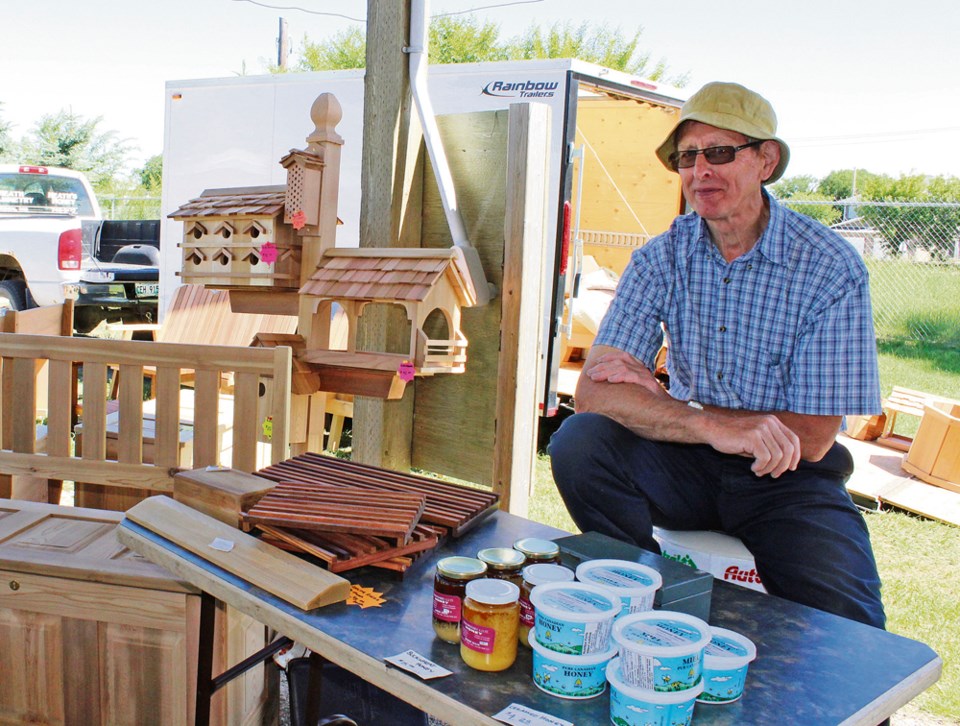Hand crafted lawn and garden furniture and whipped honey are trademarks of local craftsman Robert Heath. A family business plus personal talents are woven into Heath’s journey from his birthplace in England, to life some 70 years later, in Manitoba.
Marian and Robert Heath are rural residents near Virden. Heath, 70, is a self-employed beekeeper who markets his whipped honey locally.
He was out collecting honey when I called him for an interview a few days ago. As it turns out, even in this dry summer, this is the beekeeper’s “second best year, ever.”
British Immigrants
Born in 1948 in Great Britain, Heath farmed in Shropshire County, midway between London and Liverpool.
Heath moved to Canada in 1981, following other family members.
“There were 18 of us when we came over in 1980-81.”
His mother and grandmother, two brothers and their families, and a sister.
“They came in November and I came the following June.”
During the 20th Century many British estates, large and small, had fallen into the hands of the government and been rented out to help young farmers go into business.
That is how Heath began farming his property, a 20-acre farm and then a 48-acre parcel later.
In the 1970s British farmers had seen all time high prices, which plummeted by the end of the decade. Strikes by coal miners and other workers, soccer riots, and trouble with the IRA in Ireland were marks of the ‘70s.
Starting up in Canada
“By trade, we’re dairy farmers. My parents, when they came over, were milking 200 head of the Channel Island cattle.” Meaning Jersey and Guernsey breeds.
But getting into the Canadian dairy business was an expensive proposition, so he turned his hand to another familiar rural trade.
“I came over [to Canada] and went into commercial beekeeping.”
Just six years after start-up in Canada, in 1987 adversity struck. The bottom fell out of the honey market.
Heath then switched to another trade he was familiar with – construction.
“I’d been in construction all my life. Back in England we built our own wood-framed buildings as such. Because my grandfather’s brother was a stone mason and the farm that we grew up on had stone walls for fences, I was used to stonework.”
He worked for Nixon Builders for about eight years - until he couldn’t.
Why cabinetry
“One winter, I had some health issues and the doctor told me to find an indoor job.”
That year, Nixon Builders had constructed Bill Gardham’s shop at Hamiota – Wil-Kraft Cabinets.
“He (Gardham) told me at the time, ‘If you ever want a job, there’s one waiting for you.’”
Heath was interested.
“I’d always liked the finer side of things as opposed to framing. I enjoyed more the finishing-up side of things. I enjoyed working at Wil-Kraft Cabinets.”
After a year Heath realized he wanted a job closer to home. He answered an advertisement for maintenance with Fort La Bosse School Division and that turned into 17 years of employment.
“Once the operations supervisor got to realize that I could build cabinets, my first job was to give a quote for the secretary’s office at Goulter School.”
Since then, the carpenter did many projects for the school division, until he retired about five years ago.
His own business
Formal retirement left more time to pursue his passion for furniture building.
Heath Cabinetry began in 2000, and boasts European workmanship using Grade-A materials.
This business came about naturally as well.
“In 1986 my parents had Canadian Cedar Manufacturers at Oak Lake. I managed that for four years. They produced lawn and garden furniture.”
During the daytime in the winter he builds up a stock of furniture for the summer market.
Special hobby
Heath is a man with a penchant for detailed work. With keen interest he can explain the measurements and craft of a purple martin bird house hotel and when to put it up; or how and why he whips Shropshire Gate Honey.
Is he looking forward to retirement?
“As long as I am able, I wish to continue doing. I shall naturally slow down. I used to work to nine or 10 o’clock at night. No more. When I’m out until eight o’clock, then I call it quits.
“In the winter months, once I go in for my tea and supper at five o’clock, that’s it. That’s when I go down to the basement and do my wood carving for a couple of hours.”
Bird carvings
Carving came about rather naturally as well.
“We went out [one] particular summer to my daughter’s in Brooks, Alta.”
While he and Marian were sitting watching grandchildren swim at the lake, he realized he needed something to do; a craft.
“I vowed that I would never go out there again unless I had a piece of wood and a knife and do some whittling.”
Back at Virden, just two months later, Heath answered an ad for a six-week wood carving course. The class made a scarlet tanager. The next year he took an advanced course and has been carving ever since.
Heath has created gold finches, a blue jay, a black bird, wrens and a hummingbird.
Not ready to sell this new art form, he has made some of them gifts.




